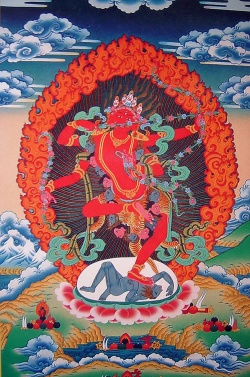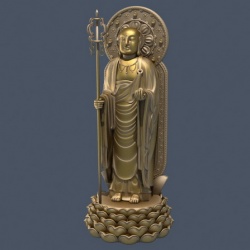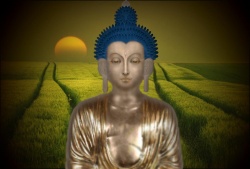Difference between revisions of "Tsoknyi Gyatso on Zhentong"
| Line 17: | Line 17: | ||
In general, though it is not possible for there to be a {{Wiki|contradiction}} amongst the consummate intent of these two authors, their ways express degrees. For [[Mati]], [[emptiness]] and [[interdependence]] are never the [[nature]] of [[enlightened essence]]. For [[Tsoknyi Gyatso]], even though he {{Wiki|conventionally}} explained [[emptiness]] and [[interdependence]] to not be the [[nature]] of [[enlightened essence]], this is not an important {{Wiki|distinction}} for him, as they are said to be [[identical]].[2] | In general, though it is not possible for there to be a {{Wiki|contradiction}} amongst the consummate intent of these two authors, their ways express degrees. For [[Mati]], [[emptiness]] and [[interdependence]] are never the [[nature]] of [[enlightened essence]]. For [[Tsoknyi Gyatso]], even though he {{Wiki|conventionally}} explained [[emptiness]] and [[interdependence]] to not be the [[nature]] of [[enlightened essence]], this is not an important {{Wiki|distinction}} for him, as they are said to be [[identical]].[2] | ||
| − | After [[Tsoknyi Gyatso’s]] lenient, if not somewhat compromised renderings on the [[nature]] ([[ngo bo]]) of [[enlightened essence]] ([[bde gshegs snying po]]), and an {{Wiki|exegetical}} style that could be characterized as a kind of “[[zhentong]] lite,” it is tempting to speculate how [[Lodro Drakpa]] might have sought to be corrective in his own writings on [[zhentong]]. Reading through the works of | + | After [[Tsoknyi Gyatso’s]] lenient, if not somewhat compromised renderings on the [[nature]] ([[ngo bo]]) of [[enlightened essence]] ([[bde gshegs snying po]]), and an {{Wiki|exegetical}} style that could be characterized as a kind of “[[zhentong]] lite,” it is tempting to speculate how [[Lodro Drakpa]] might have sought to be corrective in his own writings on [[zhentong]]. Reading through the works of [[Lodro Drakpa]], it is apparent that he makes a deliberate [[effort]] to reiterate seminal themes and core {{Wiki|principles}} of classical [[zhentong]] [[philosophical]] [[thinking]], as if seeking to re-align the {{Wiki|modern}} [[Jonang tradition]] with the works of [[Dolpopa]] and [[Taranatha]]. However, it is [[interesting]] to note that each of the running titles for [[Tsoknyi Gyatso’s]] three works on [[zhentong]] that will be published in this [[book]] begin with the words, “[[Kun mkhyen]]” or “[[Kun mkhyen Jo nang pa]],” a homage to the [[Jonang lineage]] as he inherited it from [[Kunkyen Dolpopa Sherab Gyaltsen]]. |
Endnotes: | Endnotes: | ||
| − | 1. This forthcoming [[book]] on the typeset [[Tibetan language]] works of [[Ngawang Tsoknyi Gyatso]] will be titled, [[Ngag dbang tshogs gnyis rgya mtsho'i gzhan stong phyogs sgrigs]], [[Sichuan]] Nationalities Publishing House, 2009. This [[book]] is due to the efforts of Dr. Douglas Duckworth, [[Khenpo]] [[Ngawang]] [[Dorje]], [[Khenpo Tsultrim]] [[Dargye]] and [[Khenpo]] Delek Rabgye. It is being published via the Ngedon Thartuk Publication Series and will be made possible by [[Jonang]] | + | 1. This forthcoming [[book]] on the typeset [[Tibetan language]] works of [[Ngawang Tsoknyi Gyatso]] will be titled, [[Ngag dbang tshogs gnyis rgya mtsho'i gzhan stong phyogs sgrigs]], [[Sichuan]] Nationalities Publishing House, 2009. This [[book]] is due to the efforts of Dr. Douglas Duckworth, [[Khenpo]] [[Ngawang]] [[Dorje]], [[Khenpo Tsultrim]] [[Dargye]] and [[Khenpo]] [[Delek Rabgye]]. It is being published via the Ngedon Thartuk Publication Series and will be made possible by [[Jonang Foundation]]. |
| − | 2. The full translation reads, “Here is a {{Wiki|distinction}} on the points concerning [[zhentong]] of both [[Ngawang Tsoknyi Gyatso]] and [[Mati]] [[Rinpoche]] ([[Ngawang Lodro Drakpa]]): In general, though it is not possible for there to be a {{Wiki|contradiction}} amongst the consummate intent of these two authors, their ways express degrees. For [[Mati]], [[emptiness]] and [[interdependence]] are never the [[nature]] of [[enlightened essence]]. For [[Tsoknyi]] | + | 2. The full translation reads, “Here is a {{Wiki|distinction}} on the points concerning [[zhentong]] of both [[Ngawang Tsoknyi Gyatso]] and [[Mati]] [[Rinpoche]] ([[Ngawang Lodro Drakpa]]): In general, though it is not possible for there to be a {{Wiki|contradiction}} amongst the consummate intent of these two authors, their ways express degrees. For [[Mati]], [[emptiness]] and [[interdependence]] are never the [[nature]] of [[enlightened essence]]. For [[Tsoknyi Gyatso]], even though he {{Wiki|conventionally}} explained [[emptiness]] and [[interdependence]] to not be the [[nature]] of [[enlightened essence]], this is not an important {{Wiki|distinction}} for him, as they are said to be [[identical]]. This was composed by Pande Gyatso, the one who holds the same [[name]] as [[Ngawang Tsoknyi Gyatso]], for the American named Michael.” |
</poem> | </poem> | ||
{{R}} | {{R}} | ||
[http://www.jonangfoundation.org/blog/tsoknyi-gyatso-zhentong www.jonangfoundation.org] | [http://www.jonangfoundation.org/blog/tsoknyi-gyatso-zhentong www.jonangfoundation.org] | ||
[[Category:Jonang]] | [[Category:Jonang]] | ||
Latest revision as of 01:08, 7 August 2014
Submitted by Michael R. Sheehy on Fri, 2009-07-31 03:16
Without jumping the gun (as we continue to set the text), I thought to write a post with the hope to help contextualize a forthcoming publication in the Tibetan language on the essential zhentong works by the Jonang master from Dzamthang, Ngawang Tsoknyi Gyatso (1880-1940).[1]
Zhentong — the contemplative view that the ultimate nature of reality is empty of all extraneous superficial characteristics while profusely full of the qualities that define enlightenment — has become a hallmark of the Jonang tradition of Tibetan Buddhism. From its early articulation by Tibetan forefathers of the Jonangpa in the eleventh century, up to Dolpopa Sherab Gyaltsen’s (1292-1361) formal codification, and on through later authors such as Tāranātha (1575-1635), zhentong philosophical thinking has revealed itself to be complex, nuanced, and manifold.
A subject of political and polemical dispute in Tibet throughout the ages as well as a platform that has served to unify doctrinal differences, zhentong is a technical term that has been co-opted and essentialized for a variety of purposes in multiple contexts. In fact, within the contemporary Jonang curriculum, there are distinct variants of what is unilaterally referred to as “zhentong.” One of these variants or strains of thought is derived from the works authored by Tsoknyi Gyatso, a scholar of the Jonang tradition who was considered an incarnation of one of Dolpopa’s major disciples, Nyawon Kunga Pal (1285-1364).
For reasons that deserve further research, Tsoknyi Gyatso’s writings are not only intriguing and perplexing because they present a specific species of zhentong, but they are important because they disclose to us the intentional workings of a major Jonang scholar during a fascinating period in far eastern Tibetan history. As a disciple of the great Jonang master from Dzamthang, Bamda Thubten Gelek Gyatso (1844-1904), Tsoknyi Gyatso was undoubtedly exposed to a rich nexus of views. Having lived at the crossroads of intellectual exchange during the height of the Rimé eclectic movement in Kham, Bamda Gelek studied with masters including Jamgon Kongtrul (1813-1899), Jamyang Khyentse Wangpo (1820-1892), Dza Patrul (1808-1887) and his Geluk teacher Akon. With these mentors close to his own teacher’s heart, it is safe to infer that Tsoknyi Gyatso was not only versed in the mainstream zhentong works of his own tradition from authors such as Dolpopa and Taranatha, but that he most likely inherited ways of thinking through alternative presentations of emptiness.
Though Bamda Gelek’s writings on zhentong were limited to those on tantra zhentong as found within his extensive works on the six-fold vajrayoga of the Kalachakra, and there is no evidence of writings on sutra zhentong within his collected works, an intriguing story lingers on about the zhentong text that Bamda Gelek almost wrote. As the narrative was relayed to me at his monastery in Dzamthang several years ago, Bamda Lama was at the end of his life when a small group of Jonang monks arrived to receive teachings from him. During their visit, a discussion developed about the inner meaning of zhentong and the monks then urgently requested the master to write a text on the subject. It was said that Bamda Gelek agreed, and that he started to compose this work during his final days. He even gave the text a name, “Gzhan stong rol mos gad rgyangs” or “The Roaring Melodious Laughter of Zhentong.” Before his death, Bamda Lama became consumed with his large exegesis on Prajnaparamita, and unfortunately he passed away before he was able to complete the composition of this zhentong text.
Though the sutra zhentong writings of his teacher will have to remain a mystery, we know how Tsoknyi Gyatso’s most famous student has contributed to the conversation. At the age of eighteen, Ngawang Lodro Drakpa (1920-1975) arrived at the Rashuk mountain retreat where he began his formal scholastic education with Tsoknyi Gyatso. Lodro Drakpa then spent four years studying the core textbooks within the Jonang curriculum including the major collections of sutra and tantra along with Bamda Geleks’ extensive work on the collected topics in Buddhist epistemology. However, Tsoknyi Gyatso was not Lodro Drakpa’s preceptor in the transmission of the zhentong lineage and their styles in the presentation of zhentong differ significantly. While thinking about these two authors, I thought to ask the current tulku of Tsoknyi Gyatso how specific points concerning zhentong differ between Tsoknyi Gyatso and Ngawang Lodro Drakpa, known affectionately as Mati Rinpoche. This is what he wrote for me on the spot,
In general, though it is not possible for there to be a contradiction amongst the consummate intent of these two authors, their ways express degrees. For Mati, emptiness and interdependence are never the nature of enlightened essence. For Tsoknyi Gyatso, even though he conventionally explained emptiness and interdependence to not be the nature of enlightened essence, this is not an important distinction for him, as they are said to be identical.[2]
After Tsoknyi Gyatso’s lenient, if not somewhat compromised renderings on the nature (ngo bo) of enlightened essence (bde gshegs snying po), and an exegetical style that could be characterized as a kind of “zhentong lite,” it is tempting to speculate how Lodro Drakpa might have sought to be corrective in his own writings on zhentong. Reading through the works of Lodro Drakpa, it is apparent that he makes a deliberate effort to reiterate seminal themes and core principles of classical zhentong philosophical thinking, as if seeking to re-align the modern Jonang tradition with the works of Dolpopa and Taranatha. However, it is interesting to note that each of the running titles for Tsoknyi Gyatso’s three works on zhentong that will be published in this book begin with the words, “Kun mkhyen” or “Kun mkhyen Jo nang pa,” a homage to the Jonang lineage as he inherited it from Kunkyen Dolpopa Sherab Gyaltsen.
Endnotes:
1. This forthcoming book on the typeset Tibetan language works of Ngawang Tsoknyi Gyatso will be titled, Ngag dbang tshogs gnyis rgya mtsho'i gzhan stong phyogs sgrigs, Sichuan Nationalities Publishing House, 2009. This book is due to the efforts of Dr. Douglas Duckworth, Khenpo Ngawang Dorje, Khenpo Tsultrim Dargye and Khenpo Delek Rabgye. It is being published via the Ngedon Thartuk Publication Series and will be made possible by Jonang Foundation.
2. The full translation reads, “Here is a distinction on the points concerning zhentong of both Ngawang Tsoknyi Gyatso and Mati Rinpoche (Ngawang Lodro Drakpa): In general, though it is not possible for there to be a contradiction amongst the consummate intent of these two authors, their ways express degrees. For Mati, emptiness and interdependence are never the nature of enlightened essence. For Tsoknyi Gyatso, even though he conventionally explained emptiness and interdependence to not be the nature of enlightened essence, this is not an important distinction for him, as they are said to be identical. This was composed by Pande Gyatso, the one who holds the same name as Ngawang Tsoknyi Gyatso, for the American named Michael.”


